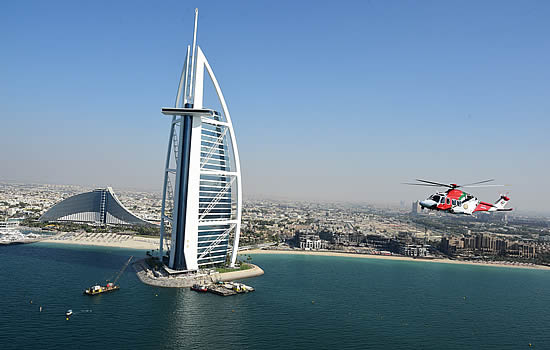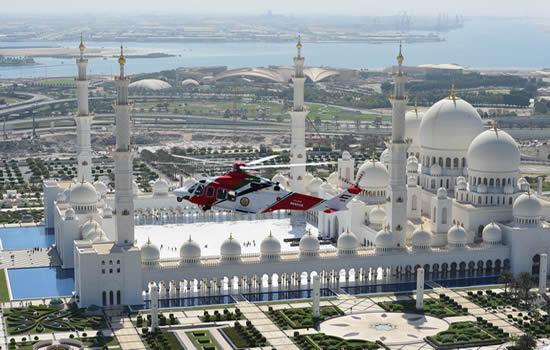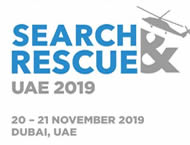The UAE National Search & Rescue Center
Written by Tom Withington
With challenging weather, desert terrain and a 711.7 nautical mile (1,318 kilometre) coastline, the United Arab Emirates’ National Search and Rescue Center (NSRC) provides a timely response to emergencies in the nation’s locale.
Established in 2013 by His Highness, Sheikh Khalifa Bin Zayed al Nahyan, President of the United Arab Emirates, Supreme Commander of the United Arab Emirates Armed Forces and Ruler of Abu Dhabi, the UAE’s National Search and Rescue Center is tasked with providing federal Search and Rescue (SAR) services for 'all land, sea and mountain rescues'.
Mohammed al Hobsi, the NSRC’s director of operations, explains that SAR operations are executed using the NSRC’s Joint Rescue Coordination Center and Mission Control Center which are used to coordinate immediate requests for search planning, SAR and SAR unit coordination. This is in addition to providing immediate medical attention during emergencies and transporting people to safe locations in the wake of an incident.

Although the NSRC does not own any SAR resources, it works very closely with the UAE’s armed forces and with the police and commercial organisations “to provide support for on-call or immediate rescue or medical evacuation requests". Importantly the UAE armed forces and the police have several assets at their disposal to assist SAR operations including aircraft, ships and vehicles. For example, in 2017 Abu Dhabi police took delivery of new Chevrolet Corvette and Tahoe rescue cars able to provide a rapid response to accidents and to render assistant at the scene. Similarly, the police in Abu Dhabi, Dubai, Ras-Al-Khaimah and Sharjah have an array of helicopters which can be used to assist SAR including AgustaWestland AB-412EP/HP, AW-139, Bell 206B and Mil Mi-8MTV1 aircraft, with a combined fleet of 13 rotor craft.
Weather and Environment
Mr. al Hobsi notes that the NSRC deals with a whole host of emergencies, the type of which tend to vary according to the time of year and local weather. Moreover, as tourism has expanded in the UAE and its maritime approaches, so have requests for SAR assistance: “The NSRC anticipates seasonal requirements for SAR services. As the weather improves in the fall and winter, requests typically come from camping or hiking incidents. During the rainy season, requests usually come from persons (and families) trapped in rising water in mountain wadis.” Similarly, local deserts in the UAE pose their own unique challenges; “In the hot season, the NSRC coordinates the rescue of persons stranded in the desert that may or may not be an emergency now but could develop into an issue if left unresolved.”

The NSRC also addresses requests for assistance in the maritime domain, particularly when passengers on ocean liners are taken ill: “The NSRC receives direct calls from cruise ship captains and vessels to provide medical evacuation for emergency medical conditions," continues Mr al Hobsi. "The responsiveness in the NSRC is underpinned by its constant vigilance of Very High Frequency (VHF) maritime distress channels.
“As per the UAE’s support to international treaty obligations, the NSRC maintains a 24-hour watch on an emergency maritime communication VHF frequency that allows for direct communication with vessels operating in the UAE maritime domain.”
However, as well as bringing its own challenges to those individuals journeying into the desert, or sailing through the UAE’s waters, the region’s weather can also create problems for the rescuers tasked with responding to calls for help: “The local weather typically is the most severe aspect of conducting rescue operations,” observes Mr. al Hobsi. “Some times of the year are extremely warm. As the weather cools, rescue units must deal with dense fog. In the winter, high winds and rough sea states are an issue.”
In addition, the NSRC works closely with neighbouring nations to provide a timely and efficient response to emergency situations which may involve multiple countries. The UAE borders Saudi Arabia in the west and south, and Oman in the east. On a day-to-day basis telephone, fax and electronic communications provide means of assisting the coordination of SAR efforts with neighbours as and when required, Mr. al Hobsi continues. Over the longer term, he adds that “the NSRC is working towards formal bi-lateral agreements with neighbouring countries” in the SAR domain.
Training and Technology
Looking towards the future, training and technology play important parts in the continued evolution of the NSRC and its mission. In terms of its workforce, “The majority of the NSRC staff come from second career persons with aviation, maritime or air traffic control experience,” Mr. al Hobsi remarks, stating that “The NSRC is also open to qualified male and female candidates to provide back office support.” Training is central to the organisation’s investment in its staff, and the center “typically brings in international experts to provide training courses on various topics relating to search planning, on-scene coordination and other crisis management fields.” External training is provided and the NSRC “considers international training academies to send its staff for operational instruction.”

As well as keeping watch on the UAE land and maritime environs to provide a timely response to those in distress, the NSRC keeps a close watch on technological trends which can help to save lives and improve the responsiveness of SAR personnel in the UAE and beyond. To this end, Mr. al Hobsi says that the NSRC is interested in technology to enhance and improve emergency radio beacons. Known formally as Emergency Position Indicating Radio Beacons these devices can be used by aircraft, ships or people on land to transmit a radio signal which can be detected by satellites. This signal can then be used by SAR personnel to locate the source of the transmission to facilitate the rescue. At sea, the NSRC evaluates “visual detection capabilities that locate survivors in water more rapidly.”
In the six years since its activation the NSRC has achieved an impressive track record saving lives on land and at sea. Investments into training and technology will sharpen the capabilities of the center yet further, something that will translate into ever-more responsive SAR provision and more people rescued from distress.
The NSRC undertakes all the assigned tasks in coordination with local and federal authorities in all aid and emergency processes in the region. Using state-of-the-art technologies and communication resources, the Center develops, coordinates and executes SAR missions in partnership with the regional and global counterparts.
Meet the NSRC leaders at the Search & Rescue UAE 2019 Conference, taking place on 20 -21 November 2019 alongside Dubai Airshow, UAE. This two-day event will provide a unique opportunity for search & rescue specialists, operators and government representatives to share experience, debate on the latest industry issues and discuss future developments.
BlueSky Business Aviation News | 10th October 2019 | Issue #528
Share this article



